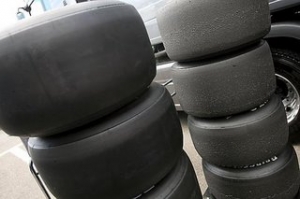The F1 tyre monopoly
 In 2006 the FIA decided to select a single tyre manufacturer that would supply all Formula One teams from 2008. Previously, there had been two tyre manufacturers in F1; Michelin and Bridgestone, but after Michelin ruled itself out of the bidding process the contract was awarded to Bridgestone.
In 2006 the FIA decided to select a single tyre manufacturer that would supply all Formula One teams from 2008. Previously, there had been two tyre manufacturers in F1; Michelin and Bridgestone, but after Michelin ruled itself out of the bidding process the contract was awarded to Bridgestone.
Without the variance of different tyre manufacturers the FIA introduced a rule in an attempt to encourage overtaking whereby in every race each driver must use both compounds chosen by Bridgestone. Now FIA Race Director, Charlie Whiting, says the difference in compounds isn’t great enough:
This year, once again, each driver will have to use two different types of slick tyres during the race. We wanted to have a bigger difference between them. Sometimes, in 2008, this gap was a matter of one or two tenths. We thought it would be better if it was bigger. The Bridgestone engineers are working on that. Sometimes, in 2008, the difference between the two types of tyres was negligible wasnt it? One couldnt see the difference between the two, really.
In a 2005 interview, Michelin’s Competitions Director Pierre Dupasquier explained why he thought the tyre monopoly was a bad idea:
As we see it, the major inconvenience is twofold; You reduce the technological showcase that is F1 to the level of a single-make formula and you would lose the interest of making new discoveries and innovating in a competitive environment.
I’ve got an idea. Instead of coming up with contrived rules so that drivers will always be on the ‘wrong’ tyre at some point in the race, why not open Formula One up to all tyre manufacturers. This would encourage competition and development and would also provide the difference in tyre performance that is enforced artificially now.